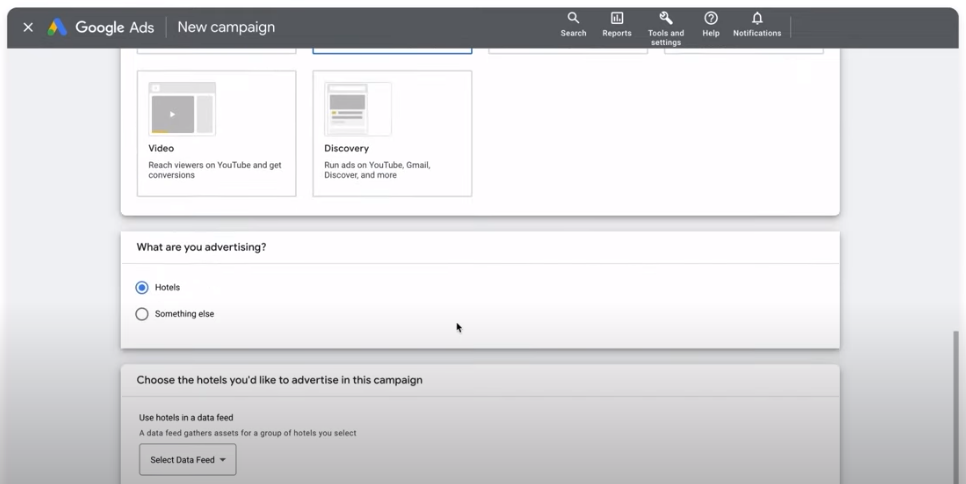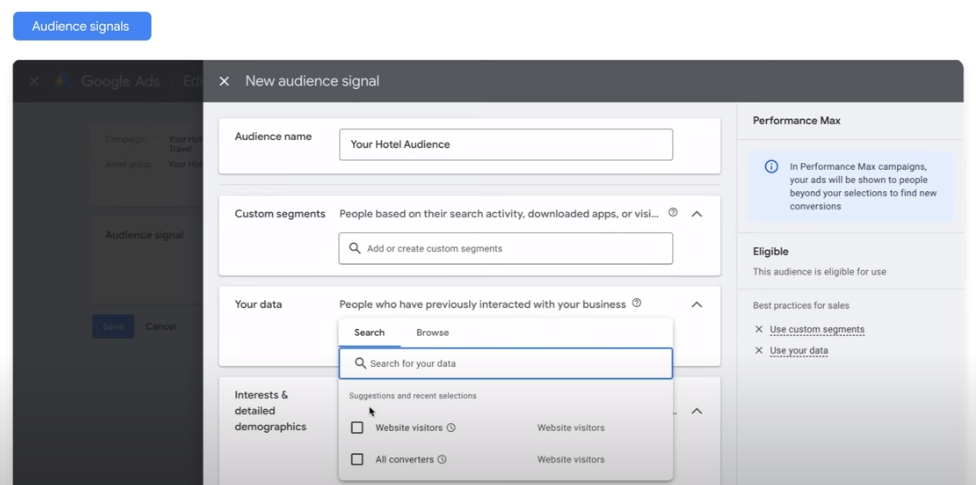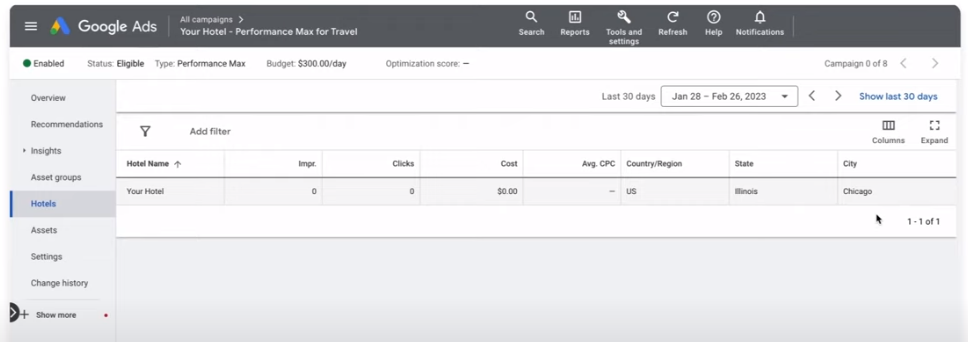SEO
How To Use Performance Max For Travel Campaigns

Google recently provided its Performance Max best practices for advertisers in the tourism and travel industry.
The need for additional support tools outside of retail and ecommerce has been strong as Google continues to prioritize Performance Max and automation.
Google’s latest tutorials video provides key steps to setting up a successful Performance Max campaign for hotel properties.
The touted benefits of Performance Max for hotels are similar to other industries:
- The ability to reach users across the full range of Google inventory
- Expand brand reach with additional ad formats and channels
- Utilizing strategic inputs to help steer Google’s AI for maximum performance.
Step 1: Prepare the Account Settings
Before jumping into campaign creation, reviewing the Business Data settings is essential.
Navigate to “Tools & Settings” >> “Business Data” and choose the “Hotel Properties” feed.
This is where advertisers choose which hotels to choose from later on in the Performance Max campaign.
For marketers with few properties, use the “hotel picker” by choosing hotels from a map.
 Image credit: Google, March 2023
Image credit: Google, March 2023If over 50 properties are used, there are three options to add them to the business data:
- Create a feed using Google Maps URLs
- Use hotels in the Hotel Center Account that is linked to the Google Ads account
- Use the Google API
Step 2: Select Campaign Settings
Now, it’s time to set up the Performance Max for Hotels campaign.
When creating a new campaign, select “Sales” as the objective, then a “Purchases” conversion action from the account.
After those selections, choose “Performance Max,” which will default to the hotel selection. The travel-specific enhancement will allow advertisers to select the data feed source (from step 1).
 Image credit: Google, March 2023
Image credit: Google, March 2023One of the most critical components is selecting a bid strategy that aligns with the company’s objectives. Choose from either maximizing:
- Conversions (if all conversions are worth the same)
- Conversion value (if each conversion has a different value, such as other hotels providing different rates, etc.)
Google recommends setting a Target CPA (Cost Per Acquisition) or Target ROAS (Return On Ad Spend) from the last 30 days, comparable to other campaigns in the account with similar goals. This helps steer Google’s AI in the right direction from the start.
Finally, adjust other settings such as the ad schedule, start and end date, and budget.
Step 3: Customize Asset Groups
The first item to choose is a default logo that can be used for any hotel within the Performance Max campaign.
Each hotel that was selected in the campaign automatically becomes its own asset group (similar to an ad group for non-Performance Max campaigns).
Asset Group components
Each asset group is made up of the following:
- Website URL
- Images
- Logo(s)
- Videos
- Text headline(s)
- Text description(s)
- Call-to-action (CTA)
 Image credit: Google, March 2023
Image credit: Google, March 2023Google’s AI will automatically copy assets from the chosen website. However, advertisers must review anything selected. Advertisers can also decide on the combinations used.
Google states that if no video assets are available, they will automatically create one based on other chosen image assets.
It’s essential to review automatically chosen assets because there’s always room for a margin of error – especially if a website is not up-to-date. Be sure to check the following:
- Grammar in headlines and descriptions
- Images and video are up-to-date and high-quality
- Logos are cropped correctly
- CTAs are aligned with website goals
Utilize Audience Signals
Advertisers also can create and upload their assets for more control. While this can be a bit more manual process, it’s better for marketers who want more campaign control.
Another critical item to add to the campaign before launching is audience signals. Start by adding any first-party or customer data available to help Google’s AI find more users most likely to book immediately.
Additional audience signals recommended to add are Google’s “In-Market” segments. Similar to first-party data, these signals steer Google’s AI to more bottom-of-funnel users ready to take action.
 Image credit: Google, March 2023
Image credit: Google, March 2023Lastly, before launching, include additional assets (formerly ‘extensions‘) such as sitelinks, callouts, and calls to make the ad more prominent.
Once these items have been created and reviewed, the campaign can be launched!
Step 4: Optimize Campaign Performance
Google recommends evaluating initial campaign performance after a few weeks from launch. This is recommended because it lets Google test, optimize, and account for any potential conversion lags or delays where customers need extra time to book.
When optimizing the Performance Max for Hotels campaign, review the following regularly:
- Look for any ad or asset disapprovals that may be affecting performance
- Individual asset performance to improve creative
- Audience signals to ensure the most relevant ads are shown to the most relevant users
Google provides property-specific reporting for advertisers to help determine an indication of traveler demand across different locations. This is valuable information to marketers as it can help influence other non-Performance Max campaigns and where to shift priorities.
In addition to property-specific reporting, it supports the ability to segment by dimensions of ‘interest’ in the “Hotel” tab on the left-hand side of the interface.
 Image credit: Google, March 2023
Image credit: Google, March 2023Performance Max for Hotels uses the same Brand Safety settings at the account level, found under “Content Suitability” in the “Tools & Settings” navigation.
Summary
As Performance Max continues to mature, so does its support for other industries outside of retail and ecommerce.
This step-by-step guide to setting up a Performance Max for Hotels campaign can help alleviate optimization pain points by checking off all the necessary initial inputs.
SEO
Google Declares It The “Gemini Era” As Revenue Grows 15%

Alphabet Inc., Google’s parent company, announced its first quarter 2024 financial results today.
While Google reported double-digit growth in key revenue areas, the focus was on its AI developments, dubbed the “Gemini era” by CEO Sundar Pichai.
The Numbers: 15% Revenue Growth, Operating Margins Expand
Alphabet reported Q1 revenues of $80.5 billion, a 15% increase year-over-year, exceeding Wall Street’s projections.
Net income was $23.7 billion, with diluted earnings per share of $1.89. Operating margins expanded to 32%, up from 25% in the prior year.
Ruth Porat, Alphabet’s President and CFO, stated:
“Our strong financial results reflect revenue strength across the company and ongoing efforts to durably reengineer our cost base.”
Google’s core advertising units, such as Search and YouTube, drove growth. Google advertising revenues hit $61.7 billion for the quarter.
The Cloud division also maintained momentum, with revenues of $9.6 billion, up 28% year-over-year.
Pichai highlighted that YouTube and Cloud are expected to exit 2024 at a combined $100 billion annual revenue run rate.
Generative AI Integration in Search
Google experimented with AI-powered features in Search Labs before recently introducing AI overviews into the main search results page.
Regarding the gradual rollout, Pichai states:
“We are being measured in how we do this, focusing on areas where gen AI can improve the Search experience, while also prioritizing traffic to websites and merchants.”
Pichai reports that Google’s generative AI features have answered over a billion queries already:
“We’ve already served billions of queries with our generative AI features. It’s enabling people to access new information, to ask questions in new ways, and to ask more complex questions.”
Google reports increased Search usage and user satisfaction among those interacting with the new AI overview results.
The company also highlighted its “Circle to Search” feature on Android, which allows users to circle objects on their screen or in videos to get instant AI-powered answers via Google Lens.
Reorganizing For The “Gemini Era”
As part of the AI roadmap, Alphabet is consolidating all teams building AI models under the Google DeepMind umbrella.
Pichai revealed that, through hardware and software improvements, the company has reduced machine costs associated with its generative AI search results by 80% over the past year.
He states:
“Our data centers are some of the most high-performing, secure, reliable and efficient in the world. We’ve developed new AI models and algorithms that are more than one hundred times more efficient than they were 18 months ago.
How Will Google Make Money With AI?
Alphabet sees opportunities to monetize AI through its advertising products, Cloud offerings, and subscription services.
Google is integrating Gemini into ad products like Performance Max. The company’s Cloud division is bringing “the best of Google AI” to enterprise customers worldwide.
Google One, the company’s subscription service, surpassed 100 million paid subscribers in Q1 and introduced a new premium plan featuring advanced generative AI capabilities powered by Gemini models.
Future Outlook
Pichai outlined six key advantages positioning Alphabet to lead the “next wave of AI innovation”:
- Research leadership in AI breakthroughs like the multimodal Gemini model
- Robust AI infrastructure and custom TPU chips
- Integrating generative AI into Search to enhance the user experience
- A global product footprint reaching billions
- Streamlined teams and improved execution velocity
- Multiple revenue streams to monetize AI through advertising and cloud
With upcoming events like Google I/O and Google Marketing Live, the company is expected to share further updates on its AI initiatives and product roadmap.
Featured Image: Sergei Elagin/Shutterstock
SEO
brightonSEO Live Blog

Hello everyone. It’s April again, so I’m back in Brighton for another two days of Being the introvert I am, my idea of fun isn’t hanging around our booth all day explaining we’ve run out of t-shirts (seriously, you need to be fast if you want swag!). So I decided to do something useful and live-blog the event instead.
Follow below for talk takeaways and (very) mildly humorous commentary. sun, sea, and SEO!
SEO
Google Further Postpones Third-Party Cookie Deprecation In Chrome

Google has again delayed its plan to phase out third-party cookies in the Chrome web browser. The latest postponement comes after ongoing challenges in reconciling feedback from industry stakeholders and regulators.
The announcement was made in Google and the UK’s Competition and Markets Authority (CMA) joint quarterly report on the Privacy Sandbox initiative, scheduled for release on April 26.
Chrome’s Third-Party Cookie Phaseout Pushed To 2025
Google states it “will not complete third-party cookie deprecation during the second half of Q4” this year as planned.
Instead, the tech giant aims to begin deprecating third-party cookies in Chrome “starting early next year,” assuming an agreement can be reached with the CMA and the UK’s Information Commissioner’s Office (ICO).
The statement reads:
“We recognize that there are ongoing challenges related to reconciling divergent feedback from the industry, regulators and developers, and will continue to engage closely with the entire ecosystem. It’s also critical that the CMA has sufficient time to review all evidence, including results from industry tests, which the CMA has asked market participants to provide by the end of June.”
Continued Engagement With Regulators
Google reiterated its commitment to “engaging closely with the CMA and ICO” throughout the process and hopes to conclude discussions this year.
This marks the third delay to Google’s plan to deprecate third-party cookies, initially aiming for a Q3 2023 phaseout before pushing it back to late 2024.
The postponements reflect the challenges in transitioning away from cross-site user tracking while balancing privacy and advertiser interests.
Transition Period & Impact
In January, Chrome began restricting third-party cookie access for 1% of users globally. This percentage was expected to gradually increase until 100% of users were covered by Q3 2024.
However, the latest delay gives websites and services more time to migrate away from third-party cookie dependencies through Google’s limited “deprecation trials” program.
The trials offer temporary cookie access extensions until December 27, 2024, for non-advertising use cases that can demonstrate direct user impact and functional breakage.
While easing the transition, the trials have strict eligibility rules. Advertising-related services are ineligible, and origins matching known ad-related domains are rejected.
Google states the program aims to address functional issues rather than relieve general data collection inconveniences.
Publisher & Advertiser Implications
The repeated delays highlight the potential disruption for digital publishers and advertisers relying on third-party cookie tracking.
Industry groups have raised concerns that restricting cross-site tracking could push websites toward more opaque privacy-invasive practices.
However, privacy advocates view the phaseout as crucial in preventing covert user profiling across the web.
With the latest postponement, all parties have more time to prepare for the eventual loss of third-party cookies and adopt Google’s proposed Privacy Sandbox APIs as replacements.
Featured Image: Novikov Aleksey/Shutterstock
-
SEARCHENGINES7 days ago
Daily Search Forum Recap: April 19, 2024
-

 WORDPRESS6 days ago
WORDPRESS6 days ago13 Best HubSpot Alternatives for 2024 (Free + Paid)
-

 MARKETING6 days ago
MARKETING6 days agoBattling for Attention in the 2024 Election Year Media Frenzy
-

 WORDPRESS6 days ago
WORDPRESS6 days ago7 Best WooCommerce Points and Rewards Plugins (Free & Paid)
-

 MARKETING5 days ago
MARKETING5 days agoAdvertising in local markets: A playbook for success
-

 SEO6 days ago
SEO6 days agoGoogle Answers Whether Having Two Sites Affects Rankings
-

 SEARCHENGINES5 days ago
SEARCHENGINES5 days agoGoogle Core Update Flux, AdSense Ad Intent, California Link Tax & More
-

 AFFILIATE MARKETING6 days ago
AFFILIATE MARKETING6 days agoGrab Microsoft Project Professional 2021 for $20 During This Flash Sale















